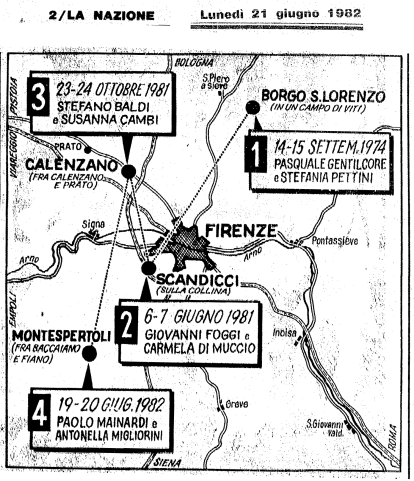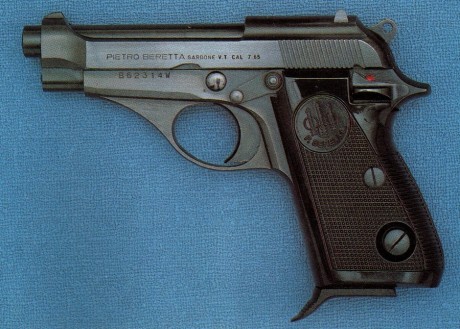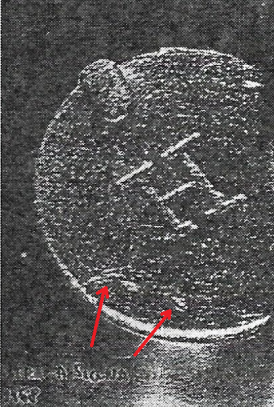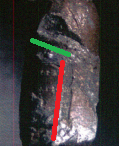Full and updated version is avaiable in Italian. See part #1 and part #2
The Monster of Florence never was officially accused by a Court as the author of the murders of Barbara Locci and Antonio Lo Bianco which took place on August 21, 1968, in Signa. For this “crime of passion” committed under the eyes of Barbara’s son, Natalino, who after the ambush arrived unharmed in a safe place, her husband, Stefano Mele, was definitively convicted on 12 April 1973.
SARDINIANS’ ACQUITTAL
Before and after having attributed the crime to himself, Mele accused some of his wife’s lovers, Francesco and Salvatore Vinci, Sardinians like him. The Vincis together with Giovanni Mele and Piero Mucciarini were investigated in the Monster case in the ’80s and completely acquitted on 13 December 1989 (Verdict). here was no evidence against them and they were in prison or under control on the occasion of some of the crimes of the serial killer (Ferri’s judgment, February 13, 1996).
The end of the “Sardinian lead” confirmed that the Signa crime could be considered extraneous to the Monster’s series of murders (Ferri’s judgment). This crime lacked all the characteristics of the mania in the Monster’s murders, which is the way the slayer stabbed the female victims or the excision of their sexual organs.
What remains today to link it to the Monster’s crimes? Monster’s bullets and shell casings stored out of the evidence room, in violation of the rules (Micheli’s judgment, p. 20), that contradict the ’68 ballistic report, the only document that might have certified their origin.
LINK
Before the summer of 1982, the investigators had not yet connected the Signa crime with the crimes of the Monster, as can also be seen in the map below published two days after the Baccaiano murders.

The connection was made on the basis of five Monster’s spent cartridges, about a month later. They were attached to the records of the Mele trial filed in the archives of the Court of Florence. Examining magistrate Vincenzo Tricomi had requested to search them in the evidence room but they were unexpectedly found in a folder of the Mele case records together with the ballistics report of ’68, unbeknownst to the judicial authority.
«The then pre-trial judge was advised. He ordered the collection of the case file. Around July 20, 1982, it was on his table. Bullets and shell casings found after the crime were attached to the case file for fortuitous and inexplicable combination.» Rotella’s judgment, p. 20
INCONSISTENCIES
The above paragraph written by judge Rotella contains an approximation. The fact that the specimens he spoke of were actually the real pieces of evidence found at the ’68 crime scene had to be proven and not taken for granted, being bodies of crime “archived” out of the rules. Shell casings and bullets among the Mele’s case records did not offer the probative strength of bodies of evidence in the right places (the evidence room or crime scene) and an immediate check should have been carried out to confirm their authenticity. Bullets and shell casings must have been compared with their descriptions in the ’68 ballistic report (which did not contain macro-photos). If matched, they were the same ones found at the crime scene in 1968. Otherwise, they were not.
In 1982, the investigators deduced that the Monster was the murderer of 1968 since there were Monster’s bullets and shell casings in the ’68 case folder. Nothing of strange, apparently, but if they had requested the necessary comparison with the ballistic report, they would have discovered that the evidence found mismatched with those described in 1968. Someone had replaced them.

COMPARISON
If the pieces of evidence of the crime in Signa were replaced with Monster’s spent cartridges, the killer had had access to the Mele case records before the crime of 1974. He had tried to copy Signa’s gun and had attached the finds from his gun to the file, in order to connect his weapon to the crimes he would have committed in the future, sidetracking the investigators. Impossible to do? The correct question is: who would not have been able to consult records of the Mele case file?
If someone gave you 10 dollars without a watermark, would you accept it? I do not think so. The concept should also be applied to the “evidence” of the Locci-Lo Bianco crime. The enclosed finds were 5 shells and 5 bullets of Winchester series H cartridges exploded from a .22 caliber, the same type of weapon that later used the Monster and which is mentioned in the ballistic report. However, brand of cartridges and type of weapon are not enough to confirm if they are the same pieces of evidence from 1968. The author of misdirection, having read the report, could have gone to a gun shop, bought a .22 caliber pistol, and that type of cartridges.
To verify the authenticity of the finds, it is necessary to take the survey of ’68 and verify that the primary prints of the weapon on the shells and bullets found at the crime scene are compatible with those found in the folder. It was not impossible to access the file of the Mele case, to find the weapon, ammunition, and evidence for replacement, but to produce signs identical to the original ones.
SHELL CASINGS WERE REPLACED
The three main marks that an automatic .22 caliber pistol leaves on the fired shells are the firing pin, extractor, and ejector marks. On the other hand, the bulging of the case at 6 o’clock with respect to the firing pin mark is a consequence of the use of high-speed cartridges in the .22 caliber pistol, not a particular sign.
In this case, it is quite easy to verify if the finds match their description. The ejector of the Monster’s weapon imprints on fired shells a characteristic mark which was described for the first time in 1974 by ballistic expert Innocenzo Zuntini.
«The five shell casings reported had clearly impressed the mark of the ejector» ’74 Zuntini’s ballistic report, p. 1
«The double mark of the ejector is detected at 7 and 9 o’clock on the back of each of them [shell casings]» ’74 Zuntini’s ballistic report, p. 11

Here is an image of two shell casings: the first one is a shell found in the folder of the Mele case, the other one, described by Zuntini in the previous quotation, was found at the crime scene of the ’74 crime. As you can see, both the fired shells have the characteristic double sign of Monster’s gun ejector detectable at 7 and 9, as the expert correctly reports. The pieces of evidence found in the Mele folder originated from the Monster, but it does not mean that they had been in that folder since 1968.
We must not overlook the fact that the abovementioned bodies of crime were not in the evidence room, where all their movements would have been recorded. The only possibility to verify their origin is to compare them with the descriptions in the ’68 report. If the shell casings found in the folder were the originals of Signa, the description of ’68 would correspond to them and to the description of ’74.
«We have observed that on all the confiscated shell casings the extractor mark (which would normally appear beyond the edge of the back of the cartridge roughly at 3 o’clock) and ejector mark (which normally would be detected on the edge of the back of the cartridge roughly at 8 o’clock) are nearly undetectable.» ’68 Zuntini’s ballistic report, p. 8
This is an observation: the marks on the real Signa shell casings are clearly not the same as the attached finds. The double sign of the ejector of the Monster’s gun was not detectable and clearly imprinted on the authentic ’68 shells, while it was easily observable even by incompetents (like me) on the shell casings found in a folder of the Mele case. Moreover, the expert postulated a different angle between firing pin and ejector from that of the attached shell casings, at 8 o’clock instead of 7 and 9 o’clock, which totally excludes that he described any of shell casings fired by Monster’s gun. Consequently the shell casings attached to the Mele case file were not the original ones and the weapon used in 1968 was not “the Monster’s gun”.
DIFFERENT BULLET
This conclusion based on the expert’s reports is supported by another observation relating to the E bullet. This find has a particularity that can be useful for possible comparisons. In 1968, it was described by Zuntini this way:
«e) bullet extracted from Lo Bianco’s body at autopsy; made of lead, copper plated, with 6 grooves etc. as the previous ones […] it shows in its deformed ogival part a metal burr points to the right, that is to the same direction of the rifling grooves twist.» ’68 Zuntini’s ballistic report, p. 10

As you can notice, the metal burr on the “ogival base” of the bullet (underlined in green) is not really a “burr” and is almost orthogonal in the opposite direction to the rifling (underlined in red). The author of misdirection was unable to reproduce Zuntini’s description and, moreover, he swapped right with left. Regardless of how the green underlined scratch was produced, this bullet confirms that a replacement of the original evidence occurred.
DIFFERENT GUN
A comparison between the spent cartridges found in the Mele case folder and Zuntini’s observations reveals the incompatibility of the main marks on the shell casings, including that of the firing pin.
The police report on the Signa case of September 21, 1968, says that, after an initial analysis, Zuntini had hypothesized that the gun used by the murderer was a Beretta, the most popular brand of pistols in Italy.
« […] the ballistics expert Colonel of Artillery Zuntini Innocenzo, who is on duty at the Artillery Command of the 7th Comiliter of Florence, ascertains from the examination of the shell casings found [on the crime scene] that it is a pistol, presumably Beretta caliber .22 , old, rusty and worn.» ’68 police report, p. 21
The ballistic report delivered to the Prosecutor’s office in Florence on the following 30 October does not mention the Beretta brand, even if tests at the shooting range were logically also carried out with Beretta .22 caliber pistols, therefore with a gun Beretta 70 series such as the one supposed to have been used by the Monster.
«Test firings with 35 different weapons .22 caliber long rifle type were conducted but in none of them we were able to find a firing pin that gave a percussion mark of the same shape of that impressed on the seized shell casings.» ’68 Zuntini’s ballistic report, p. 21
It can be concluded that Signa’s weapon was probably not even a Beretta. Zuntini was unable to ascertain the brand of the gun, despite having hypothesized that it was a Beretta, while he easily found a positive match between the serial killer’s weapon and the Beretta Model 70 in the first real case attribute to the Monster in 1974. This constatation definitively excludes that the weapon of ’68 was the same that fired the shell casings found in the Mele case folder in 1982.
«The mark of the fire pin on the edge has the shape of a rectangular bar, size 1,6 x 0,75 mm, which is typical of the Beretta’s gun.» ’74 Zuntini’s ballistic report, p. 1
What remains of the connection between the ’68 case and the Monster, then? The assumption that it was difficult to access a Court clerk’s office to consult documents and replace pieces of evidence stored (without the knowledge of the judicial authority) among records of a closed case. This is an illusion disproved by the comparison between the pieces of evidence found in the Mele case file and the ’68 ballistic report, regardless of how and by whom the misdirection was carried out (probably the Monster himself).

You must be logged in to post a comment.